Fri, September 15, 2023
Two Russian cosmonauts and an American astronaut docked with the International Space Station on Friday after blasting off from Baikonur amid raging tensions between Moscow and Washington over Ukraine.
Earlier Friday Roscosmos cosmonauts Oleg Kononenko and Nikolai Chub and NASA astronaut Loral O'Hara lifted off from the Baikonur cosmodrome in Kazakhstan aboard the Soyuz MS-24 spacecraft.
The crew docked at the ISS three hours later, the Russian space agency said.
At the orbiting station the trio will join three Russians, two Americans, a Japanese astronaut and a representative of the European Space Agency.
The liftoff took place after Russia's first lunar mission in nearly 50 years failed last month.
The ISS is a rare venue for cooperation between the United States and Russia, whose ties broke down after Moscow unleashed its offensive in Ukraine last year.
Kononenko alluded to the tensions during a pre-flight press conference on Thursday, saying that "unlike on earth" cosmonauts and astronauts took care of each other in space.
"We hear each other there, and we understand each other, and we are very sensitive to our relationships," he said. "We always take care of each other."
- 'ISS legacy' -
O'Hara praised the station's "legacy" and said it had been bringing the countries together.
"I'm excited to get on board and see the crewmates who are waiting for us," she added.
Kononenko, 59, and Chub, 39, were scheduled to spend a year on the ISS, while O'Hara, 40, was to spend six months aboard. It was the first mission to space for both O'Hara and Chub.
Chub said that travelling to space was his "childhood dream" and he had dedicated "all his life" to reaching that goal.
Russian President Vladimir Putin is looking to strengthen space cooperation with China after ties with the West broke down following the start of Moscow's offensive in Ukraine last year.
On Wednesday, Putin hosted the reclusive leader of North Korea, Kim Jong Un, at Russia's new Vostochny spaceport in the Far East, and the two discussed the possibility of sending a North Korean into space.
Last month Russia's Luna-25 module crashed on the Moon's surface after an incident during pre-landing manoeuvres, in a huge embarrassment for Moscow.
The Luna-25 mission was meant to mark Russia's return to independent Moon exploration in the face of financial troubles and corruption scandals, and its growing isolation from the West.
Moscow last landed a probe on the Moon in 1976, before shifting away from lunar exploration in favour of missions to Venus and building the Mir space station.
Dave Mosher,Hilary Brueck,Maiya Focht
Fri, September 15, 2023
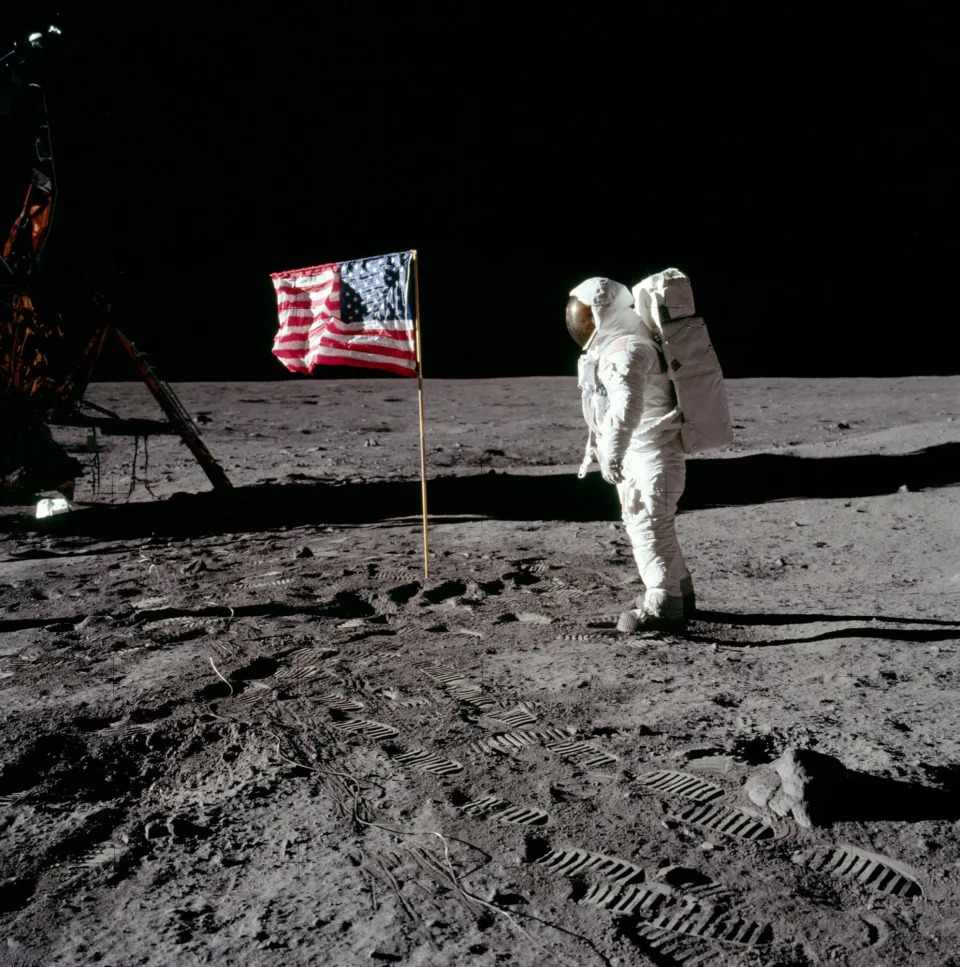
Apollo 11 astronauts planted a flag on the moon on July 20, 1969.NASA
The last time a person visited the moon was in December 1972, during NASA's Apollo 17 mission.
Astronauts say the reasons why are budgetary and political, not scientific or technical.
It's possible NASA could land people on the moon again by 2025, at the very earliest.
Landing 12 people on the moon remains one of NASA's greatest achievements, if not the greatest.
Astronauts on the Apollo missions of the 1960s and '70s collected rocks, took photos, performed experiments, planted flags, and then came home. But those stays didn't establish a lasting human presence on the moon.
More than 50 years after the most recent crewed moon landing — Apollo 17 in December 1972 — there are plenty of reasons to return people to Earth's giant, dusty satellite and stay there.
NASA has promised that we will see US astronauts on the moon again soon-ish — maybe by 2025 at the earliest, in a program called Artemis, which will include the first woman, Black astronaut, and Canadian to touch the lunar surface.
Former NASA Administrator Jim Bridenstine, who ran the agency during the Trump administration, said it's not science or technology hurdles that have held the US back from doing this sooner.
"If it wasn't for the political risk, we would be on the moon right now," Bridenstine said on a phone call with reporters in 2018. "In fact, we would probably be on Mars."
So why haven't astronauts been back to the moon in more than 50 years?
"It was the political risks that prevented it from happening," Bridenstine said. "The program took too long and it costs too much money."
Researchers and entrepreneurs have long pushed for the creation of a crewed base on the moon — a lunar space station.
"A permanent human research station on the moon is the next logical step. It's only three days away. We can afford to get it wrong and not kill everybody," Chris Hadfield, a former astronaut, previously told Insider. "And we have a whole bunch of stuff we have to invent and then test in order to learn before we can go deeper out."
A lunar base could evolve into a fuel depot for deep-space missions, lead to the creation of unprecedented space telescopes, make it easier to live on Mars, and solve long standing scientific mysteries about Earth and the moon's creation. It could even spur a thriving off-world economy, perhaps one built around lunar space tourism.
But many astronauts and other experts suggest the biggest impediments to making new crewed moon missions a reality are banal and somewhat depressing.
It's really expensive to get to the moon — but not that expensive
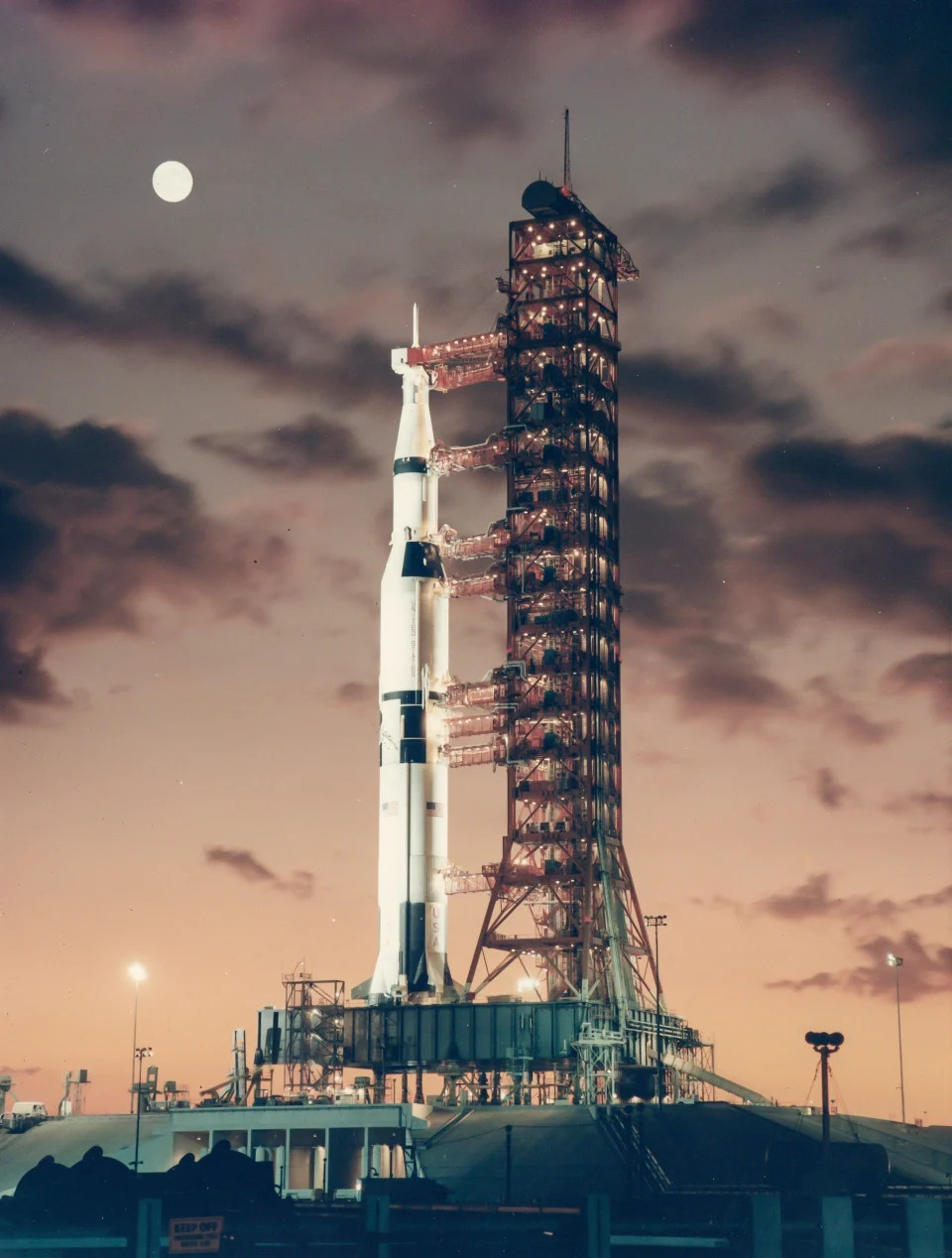
The Saturn V rocket helped power the Apollo missions.Bloomsbury Auctions
A tried-and-true hurdle for any spaceflight program, especially missions that involve people, is the steep cost.
NASA's 2023 budget is $25.4 billion, and the Biden administration is asking Congress to boost that to $27.2 billion for 2024.
Those amounts may sound like a windfall, until you consider that the total gets split among all the agency's divisions and ambitious projects: the James Webb Space Telescope, the giant rocket project called Space Launch System, and far-flung missions to the sun, Jupiter, Mars, the asteroid belt, the Kuiper belt, and the edge of our solar system.
By contrast, the US defense budget for 2023 is about $858 billion.
Plus, NASA's budget is somewhat small relative to its past.
"NASA's portion of the federal budget peaked at 4% in 1965," Apollo 7 astronaut Walter Cunningham said during congressional testimony in 2015.
To compare, NASA's 2023 budget represents roughly 0.5% of US spending, according to a report from the Planetary Society. It has fluctuated between 0.4% and 1% since the 1970s, the report said.
Returning to the moon costs a significant chunk of that budget. A 2021 report from NASA estimated that the Artemis program to return people to the moon would cost a total of $93 billion from 2012 through 2025.
The Apollo program, for comparison, cost about $257 billion in today's dollars.
"Manned exploration is the most expensive space venture and, consequently, the most difficult for which to obtain political support," Cunningham said during his 2015 testimony.
He added, according to Scientific American: "Unless the country, which is Congress here, decided to put more money in it, this is just talk that we're doing here."
Referring to Mars missions and a return to the moon, Cunningham said, "NASA's budget is way too low to do all the things that we've talked about."
The problem with presidents
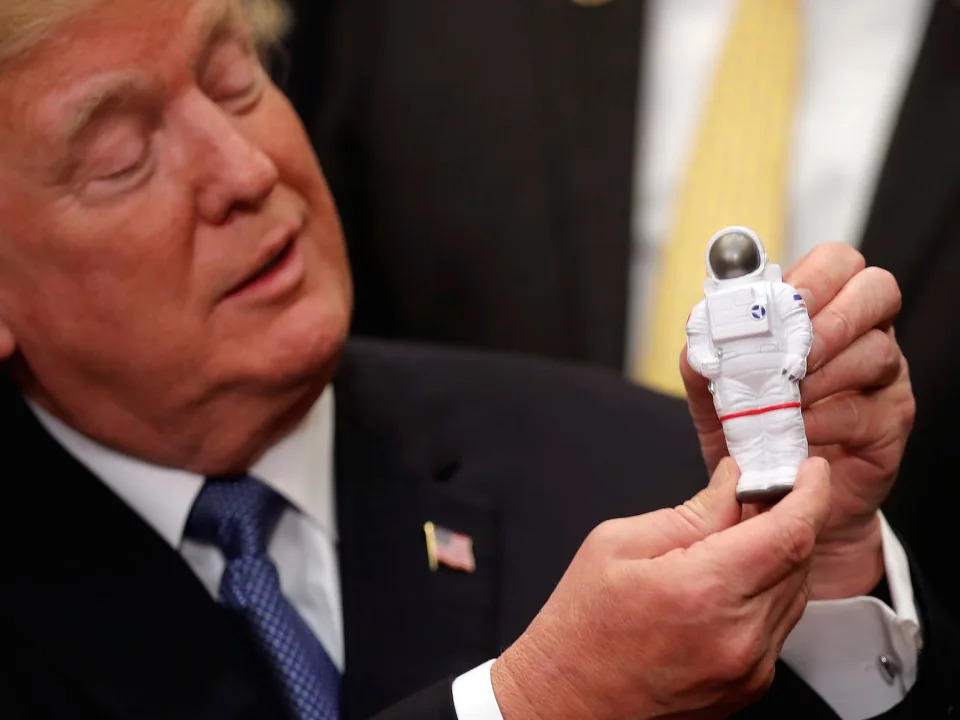
Former US President Donald Trump wanted to get astronauts back on the moon in 2024.Reuters/Carlos Barria
President Joe Biden may — or may not — be in office the next time NASA plans to land astronauts back on the moon in 2025, or later.
And therein lies another major problem: partisan political whiplash.
"Why would you believe what any president said about a prediction of something that was going to happen two administrations in the future?" Hadfield previously told Insider. "That's just talk."
The process of designing, engineering, and testing a spacecraft that could get people to another world easily outlasts a two-term president. But incoming presidents and lawmakers often scrap the previous leader's space-exploration priorities.
"I would like the next president to support a budget that allows us to accomplish the mission that we are asked to perform, whatever that mission may be," Scott Kelly, an astronaut who spent a year in space, wrote in a Reddit "Ask Me Anything" thread in January 2016, before Trump took office.
But presidents and Congress don't often seem to care about staying the course.
In 2004, for example, the Bush administration tasked NASA to come up with a way to replace the space shuttle, which was set to retire, and also return to the moon. The agency came up with the Constellation program to land astronauts on the moon using a rocket called Ares and a spaceship called Orion.
NASA spent $9 billion over five years designing, building, and testing hardware for that human-spaceflight program.
Yet after President Barack Obama took office — and the Government Accountability Office released a report about NASA's inability to estimate a realistic cost for Constellation — Obama pushed to scrap the program and signed off on the SLS rocket instead.
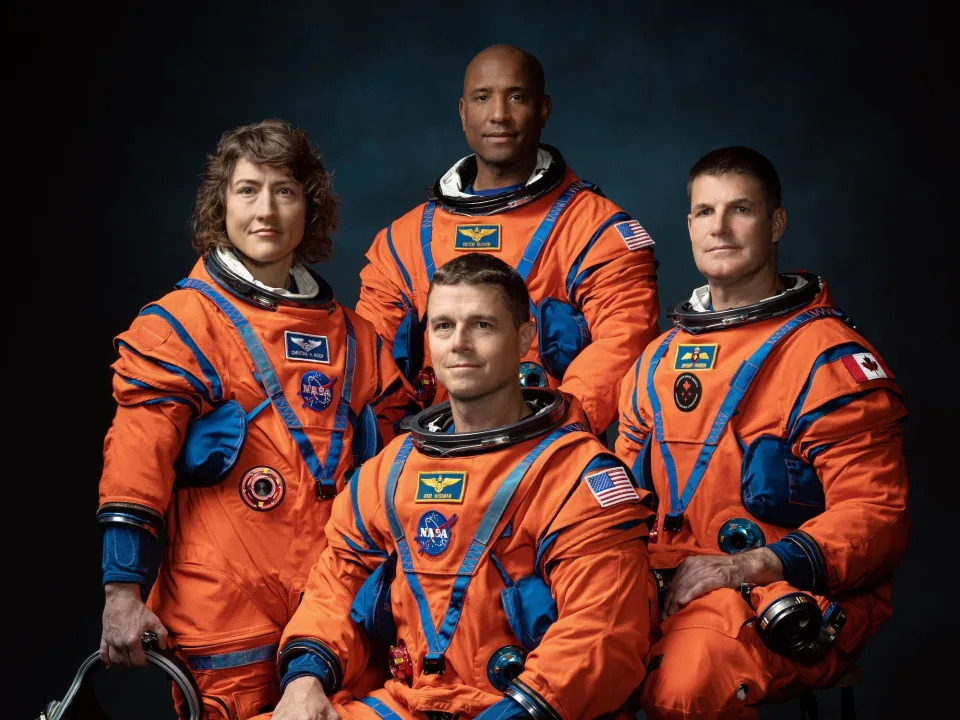
The crew of NASA’s Artemis II mission (left to right): NASA astronauts Christina Hammock Koch, Reid Wiseman (seated), Victor Glover, and Canadian Space Agency astronaut Jeremy Hansen.NASA
Trump didn't scrap SLS. But he did change Obama's goal of launching astronauts to an asteroid, shifting priorities to moon and Mars missions. Trump wanted to see Artemis land astronauts back on the moon in 2024.
Such frequent changes to NASA's expensive priorities have led to cancellation after cancellation, a loss of about $20 billion, and years of wasted time and momentum.
Biden seems to be a rare exception to the shifty presidential trend: he hasn't toyed with Trump's Artemis priority for NASA, and he's also kept the Space Force intact.
Buzz Aldrin said in testimony to Congress in 2015 that he believes the will to return to the moon must come from Capitol Hill.
"American leadership is inspiring the world by consistently doing what no other nation is capable of doing. We demonstrated that for a brief time 45 years ago. I do not believe we have done it since," Aldrin wrote in a statement. "I believe it begins with a bipartisan congressional and administration commitment to sustained leadership."
The real driving force behind that government commitment to return to the moon is the will of the American people, who vote for politicians and help shape their policy priorities. But public interest in lunar exploration has always been lukewarm.
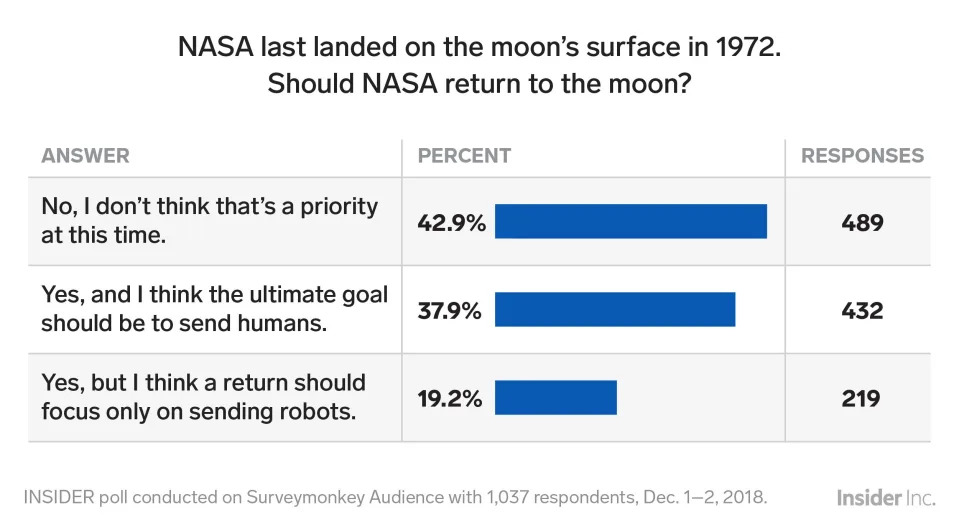
Samantha Lee/Business Insider
Even at the height of the Apollo program, after Aldrin and Neil Armstrong stepped onto the lunar surface, only 53% of Americans said they thought the program was worth the cost. Most of the rest of the time, US approval of Apollo hovered below 50%.
Most Americans think NASA should continue leading space exploration, a 2023 Pew Research Poll found. But that doesn't mean people care about going back to the moon – only 12% of the 10,329 respondents said NASA should prioritize human lunar missions.
Support for crewed Mars exploration isn't much stronger, with 11% of the poll's respondents saying it should be a NASA priority. Meanwhile, 60% think that scanning the skies for killer asteroids is important.
Many space enthusiasts have long hoped to build a base on the moon, but the lunar surface's harsh environment wouldn't be an ideal place for humans to thrive.NASA
The challenges beyond politics include problematic regolith and eye-popping temperature fluctuations
The political tug-of-war over NASA's mission and budget isn't the only reason people haven't returned to the moon. The moon is also a 4.5-billion-year-old death trap for humans and must not be trifled with or underestimated.
Its surface is littered with craters and boulders that threaten safe landings. The US government spent what would be tens of billions in today's dollars to develop, launch, and deliver satellites to the moon to map its surface, and help mission planners scout for possible Apollo landing sites.
But a bigger worry is what eons of meteorite impacts have created: regolith, also called moon dust.
Following the Apollo missions, scientists quarantined the astronauts for two weeks after they landed, in part because they were worried about the effects of the dust, according to a 2022 NASA study. The fine powder that sits on the moon's surface stuck to their suits, vehicles, and even got inside their spacecraft.
Peggy Whitson, an astronaut who has spent 675 days in space, previously told Insider that the Apollo missions "had a lot of problems with dust."
"If we're going to spend long durations and build permanent habitats, we have to figure out how to handle that," Whitson said.
There's also a problem with sunlight and deadly solar radiation.
For about 14 days at a time, the side of the moon facing Earth is a boiling hellscape that is exposed directly to the sun's harsh rays; the moon has very little atmosphere, and therefore no protection against solar radiation.
The next 14 days that same side is in total darkness, dipping to temperatures below -200 degrees Fahrenheit, making the moon's surface one of the colder places in the solar system.
NASA is developing a fission power system that could supply astronauts with electricity during weeks-long lunar nights — which would also be useful on other worlds, including Mars.
"There is not a more environmentally unforgiving or harsher place to live than the moon," astronautical engineer Madhu Thangavelu wrote. "And yet, since it is so close to the Earth, there is not a better place to learn how to live, away from planet Earth."
NASA has designed dust- and sun-resistant spacesuits and rovers, though it's uncertain whether that equipment is anywhere near ready to launch.
"I already knew going to the moon was hard," Reid Weisman, Artemis II Mission Commander, said at a press conference in August 2023. "But boy, it's harder than I thought."
A generation of billionaire 'space nuts' may get there
Another issue, astronauts say, is NASA's graying workforce. In 2019, more American kids polled said they dreamt about becoming YouTube stars, rather than astronauts.
"You've got to realize young people are essential to this kind of an effort," Apollo 17 astronaut Harrison Schmitt previously told Insider. "The average age of the people in Mission Control for Apollo 13 was 26 years old, and they'd already been on a bunch of missions."
An estimated 14% of NASA's workforce is over 40 years old, according to a Zippia analysis.
"That's not where innovation and excitement comes from. Excitement comes from when you've got teenagers and 20-year-olds running programs," Rusty Schweickart, former NASA astronaut, said. "When Elon Musk lands a [rocket booster], his whole company is yelling and screaming and jumping up and down."
Musk is part of what astronaut Jeffrey Hoffman has called a "generation of billionaires who are space nuts," developing a new, private suite of moon-capable rockets.
"The innovation that's been going on over the last 10 years in spaceflight never would've happened if it was just NASA and Boeing and Lockheed," Hoffman told journalists during a roundtable in 2018. "Because there was no motivation to reduce the cost or change the way we do it."
Hoffman was referring to the innovative work of Musk's rocket company, SpaceX, as well as by Jeff Bezos, who founded aerospace company Blue Origin.
"There's no question: If we're going to go farther, especially if we're going to go farther than the moon, we need new transportation," Hoffman added. "Right now we're still in the horse-and-buggy days of spaceflight."
Many astronauts' desire to return to the moon aligns with Bezos' long-term vision. Bezos has floated a plan to start building the first moon base using Blue Origin's New Glenn rocket system.
"We will move all heavy industry off of Earth, and Earth will be zoned residential and light industry," he said in April 2018.
Musk has also spoken at length about how SpaceX's Starship launch system could pave the way for affordable, regular lunar visits. SpaceX might even visit the moon before NASA in this century.

A picture shows Starship fully stacked on its launchpad. Elon Musk said Wednesday the rocket is 'ready to launch' on its second fully integrated flight, pending regulatory approval.SpaceX
"My dream would be that someday the moon would become part of the economic sphere of the Earth — just like geostationary orbit and low-Earth orbit," Hoffman said. "Space out as far as geostationary orbit is part of our everyday economy. Someday I think the moon will be, and that's something to work for."
SpaceX launched its complete Starship system for the first time in April.
But the rocket didn't make it to orbit as planned. Leaking propellant triggered fires in the booster, causing the system to veer off course, ultimately triggering the mega-rocket to self-destruct.
Even so, astronauts don't doubt whether or not we'll get back to the moon and onto Mars. It's just a matter of when.
"I guess eventually things will come to pass where they will go back to the moon and eventually go to Mars — probably not in my lifetime," 95-year-old retired NASA Astronaut Jim Lovell, who flew to the moon on Apollo 8 and Apollo 13, said. "Hopefully they'll be successful."

No comments:
Post a Comment